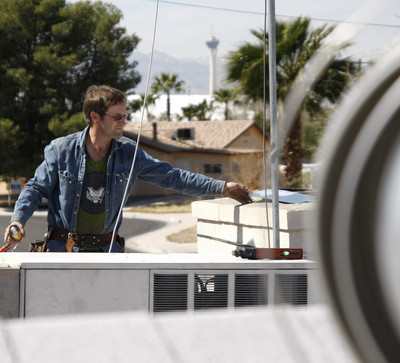DAMAGE CONTROL
It seems that the only time we give much thought to our roof is around December when Santa visits. Hopefully, he'll notice that the roof is in good shape and then take off after leaving us assorted gifts and goodies.
Well, there are many roofs that may look nice, but you can't always tell a house by its cover because underneath those tiles and shingles may lie a disaster waiting to happen. Therefore, according to John Scanlon, owner of Let It Rain Roofing, it makes sense to inspect a roof at least twice a year.
"Roofs, no matter where you live, are exposed to rainwater and the elements," said Scanlon. "In Southern Nevada, those elements are severe heat and wind. Now is a good time to have an experienced roofer check for damage or any other aspects of the roof that an uneducated eye wouldn't notice. For instance, last month we had some exceptionally windy weather and those winds can peel back and break off tiles or shingles and cause the underlying structure to fatigue or bend."
The objective of performing an annual roof inspection is threefold: to determine if the roof is performing according to its intended function; to identify signs of weakness or hazard; and to identify needed repairs.
Television handyman Bob Vila said a visual survey should include looking for holes, sagging or other signs of deterioration of the roof's foundation.
"An examination of shingles or other roofing material will signal cracks or tearing," he said. "Also check for aging such as blistering, delaminating seams, and granule loss. Investigate sheet-metal flashings around vents, chimneys and rooftop air-conditioning systems. Then, examine drains and gutters as downspouts can fill with leaves and other debris and this can cause water to back up and seep under roofs. And pay special attention to the portion of the roof that faces south as that area is constantly exposed to sun."
If the inspection reveals damage or wear that requires repairs, schedule those repairs to avoid even greater roofing costs. Scanlon said spring and summer are good times to have the work done because it's dry and the work can go quickly.
He also suggests keeping all statements including when the roof was last replaced, recording when those repairs were made, and retaining all warranties for roofing materials or workmanship.
"If the roof is properly laid, it should last indefinitely," he explained. "It's not the materials, it's the workmanship."
While tile seems to be the favorite type of roof throughout the county, asphalt shingles are just as solid and less expensive. Scanlon said it is more an architectural decision rather than if it's the best type of roof.
"Shingles are just as solid and less expressive, so it becomes a matter of style and design preference," he said. "I still do a lot of shingle roofs and the materials being produced today, the kind that cover a great majority of homes here, are usually guaranteed for 20 or 30 years. There is even a thick architectural shingle that is about twice as thick as the more common shingle with the layers staggered to give them a heavier, more substantial look. It's an excellent value."
So what's it really like laying a roof during August when the temperature is 109 F for 12 straight days?
"I cried almost every single day during the first summer I started roofing," remembered Scanlon. "Now I'm used to it, but it still takes a toll."
Copley News Service also contributed to this article.






















